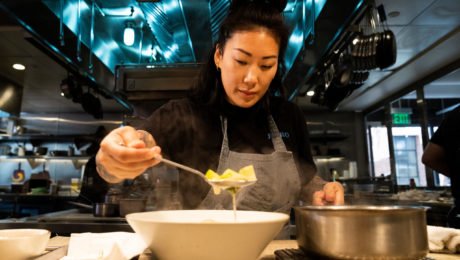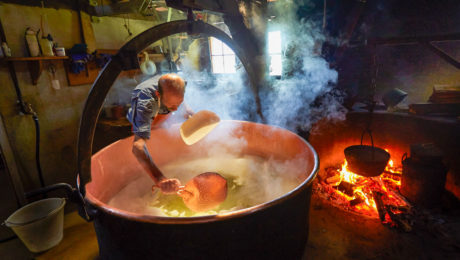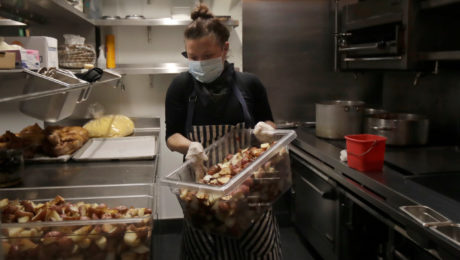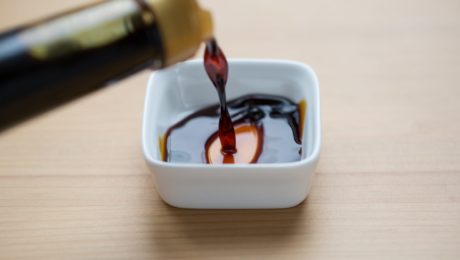“Koreanique” Food
As more Korean adoptees come of age to run restaurants, a new dining style is emerging: “Koreanique” (or Korean-style, Korean-inspired or “kinda Korean”).
“For these chefs, cooking is the ultimate reclamation of their Koreanness — and an act that pushes the cuisine to exciting places,” reads an article in The New York Times.
They produce dishes that “reflect their American upbringings and Korean heritage” of the adoptee chefs. Examples are: Jewish matzo ball soup with Korean mirepoix, Spam musubi burritos, kimchi-enriched carbonara, chicken marinated in kimchi brine, battered fish-sauce-laden zucchini with a sweet soy dipping sauce, jajangmyeon sauce with Bolognese and gochujang barbecue sauce.
Still, they note, feelings of imposter syndrome and cultural appropriation can take over. Adoptee chefs tell The Times they worry they’re not making Korean food authentically and they struggle with their complicated relationships with Korean food when they grew up eating a different culture’s food.
Read more (The New York Times)
- Published in Food & Flavor
Would You Drink Fermented Horse Milk?
The country of Kyrgyzstan is hoping to attract tourists by highlighting traditional kumis – fermented mare’s milk. Locals drink and bathe in the liquid for health benefits. Promotional films romanticize a visit to the Asian country, highlighting how one can experience the nomadic Kyrgyz lifestyle by sleeping in a mountain yurt near herds of horses.
“We decided to try it after hearing about saamal (another word for mare’s milk) and kumis from our friends who had visited Kyrgyzstan,” says Ibrahim al-Sharif, a tourist from Mecca, Saudi Arabia, in a CNN Travel article. “I cannot even describe its taste. There is nothing in Saudi Arabia that I would compare with it.”
CNN notes “milking a mare is far trickier than milking a cow.” A person must be big enough to reach their arms around the horse’s thigh. A milking is not done year round but in mid-May and mid-July, traditionally ending when the Pleiades star cluster appears.
Read more (CNN)
- Published in Food & Flavor
‘Ferming’ the Future of Food
The New York Times latest food article deep-dives into the precision fermentation that produces alternative foods, biotechnology that could turn the agriculture industry “from farming to ‘ferming.’”
The American food system is unsustainable, according to the article, with factories and feedlots producing one-third of the world’s greenhouse gas emissions. But scientists have an answer for producing protein-rich, sustainable, cheap food: precision fermentation. Using this biotech method, components of animal products (such as beef or eggs) are isolated, and then their cells are multiplied in large vats. But scaling is proving problematic.
“Precision fermentation is the most important environmental technology humanity has ever developed,” says George Monbiot, an ecologist and journalist. “We would be idiots to turn our back on it.”
Startups are lacking infrastructure and even knowledgeable employees “in a food industry trained to support animal farming.” Dr. Liz Specht, vice president of science and technology at the Good Food Institute, says we’re living in a “critical moment for governments to invest,” similar to what’s been done in the renewable energy sector in recent years. Regulations and intellectual property are also concerns.
Read more (The New York Times)
Domesticating Fermented Food Microbes
Humans have domesticated plants and animals since the early days of civilization, changing the life cycles, appearances and behaviors of crops and livestock. A new study shows humans have done the same to fermented products, selectively taming microbes. But as a result, microbial strains have evolved to where they can no longer survive in the wild.
“The burst of flavor from summer’s first sweet corn and the proud stance of a show dog both testify to the power of domestication,” reads an article in Science titled “Humans tamed the microbes behind cheese, soy, and more.” “But so does the microbial alchemy that turns milk into cheese, grain into bread, and soy into miso. Like the ancestors of the corn and the dog, the fungi and bacteria that drive these transformations were modified for human use. And their genomes have acquired many of the classic signatures of domestication.”
Humans have used selective breeding to produce the most desired traits in plants and animals – for example, making a plant less bitter or an animal larger. Thousands of years of domestication have changed DNA. Though microbes can’t be bred the same way, “humans can grow microbes and select variants that best serve our purposes.” It’s now left “genetic hallmarks similar to those in domesticated plants and animals: The microbes have lost genes, evolved into new species or strains and become unable to thrive in the wild.”
Scientists shared this research during two talks at Microbe 2022, the annual meeting of the American Society for Microbiology in Washington D.C. The talks – “Origins and Consequences of Microbial Strain Diversity” and “Microbial Diversity in Food Systems: From Farm to Fork”
– were convened by TFA Advisory Board members Benjamin Wolfe, PhD, ofTufts University, and Josephine Wee, PhD, from Penn State. They invited various academics to present their research on these topics.
Microbial Domestication in Cheese
Wolfe said the studies “are getting to the mechanisms” of how microbial domestication works. They reveal “which genes are key to microbes’ prized traits – and which can be lost,” continues the Science article. This work is critical to the future of food, as these microbe gene traits can shape fermented foods and beverages.
Presenters included Vincent Somerville, PhD, from the University of Lausanne, Switzerland, speaking on the changing genomic structure of cheese cultures. He pointed out that bread yeasts have long been domesticated. They’ve lost so much of their genetic variation that they can’t live in the wild. Other microbes are “lacking clear evidence of domestication … in part because [their] microbial communities can be hard to study,” he said.
Somerville’s research revolves around a starter culture for a Swiss hard cheese. Bacterial cheese starters were created by early cheesemakers; in the 70s, samples of these cultures began being banked to ensure quality. But Somerville and his collaborators, after sequencing the genomes of more than 100 of these samples, found little genetic diversity, with just a few strains of two dominant species..
“The exciting thing from this work was having samples over time,” Wolfe said. “You can see the shaping of diversity,” with changes in the past 50 years hinting at the trajectory of change over past centuries.
Domesticated vs. Wild Aspergillus
John Gibbons, a genomicist at the University of Massachusetts, Amherst, presented on Aspergillus oryzae, “the fungus that jump-starts production of sake from rice, and soy sauce and miso from soybeans.” Farmers cultivate A. oryzae, which reproduces on its own. “But when humans take a little finished sake and transfer it to a rice mash to begin fermentation anew, they also transfer cells of the fungal strains that evolved and survived best during the first round of fermentation,” the article reads.
Gibbons compared the genomes of A. oryzae strains with those of A. flavus, it’s wild ancestor. Human involvement in transferring the fungus has “boosted A. oryzae’s ability to break down starches and to tolerate the alcohol produced by fermentation.” The domesticated Aspergillus strains may have up to five times the number of genes used to break down starches compared to their ancestors.
“The restructuring of metabolism appears to be a hallmark of domestication in fungi,” he said.
Gibbons also found the genes of domesticated A. oryzae to have little variation. And some key genes have disappeared, “including those for toxins that would kill the yeast needed to complete fermentation — and which can make humans sick.” The article concludes: “Domestication has apparently made A. oryzae more human friendly, just as it bred bitter flavors out of many food plants.”
- Published in Science
The Unsung History of Umami
In the early 1900s, Japanese chemist Dr. Kikunae Ikeda discovered the flavor umami by distilling it from soup stock. That compound – which is an amino acid, glutamate — produces the savory flavor in meat, mushrooms and seaweed. Ikeda called the flavor after the Japanese word umami which means “essence of deliciousness.”
“It is the peculiar taste which we feel as umai, meaning brothy, meaty or savory, arising from fish, meat and so forth,” Ikeda wrote in the Journal of Tokyo Chemical Society.
A huge discovery, umami became the fifth flavor next to salty, sweet, sour and bitter. Ikeda went on to start a company, Ajinomoto, which mass produces monosodium glutamate — MSG — a key ingredient in producing umami.
But it took nearly 100 years for umami to be recognized by the broader scientific community, especially in the western world. An NPR story points to the anti-Asian “Chinese Restaurant Syndrome” which began in the 60s and 70s. MSG was vilified as an unhealthy additive, numbing mouths and making people sick (an apparent fable modern food scientists have never been able to prove). Another reason: umami research may have been ignored in the U.S. because of tension with Japan during World War II .
“Fermented foods and seasonings like sake, soy sauce, miso were a large part of the diet in Japan and also a large part of the economy. And so research into the flavor components of those kinds of foods were an important part of rationalizing diet in Japan.”
says Victoria Lee, professor and author of “The Arts Of The Microbial World.”
Read more (NPR)
- Published in Food & Flavor
Life on Mars, Thanks to Kombucha
For decades, scientists and astronauts have studied if living on Mars is feasible. The harsh environment on the planet suggests few – if any – living things can survive. But new research has revealed something interesting: kombucha can survive in extraterrestrial conditions.
Scientists found the bacteria in a kombucha SCOBY, Komagataeibacter, can survive on Mars. The research, part of the Biology and Mars Experiment (BIOMEX), began in 2014, when kombucha cultures were sent to the International Space Station. Scientists hoped cellulose, “the genomic architecture of kombucha” could survive in space, and Komagataeibacter produces cellulose.
“Based on our metagenomic analysis, we found that the simulated Martian environment drastically disrupted the microbial ecology of kombucha cultures,” said Bertram Brenig, professor at University of Göttingen’s Institute of Veterinary Medicineand head of the study . “However, we were surprised to discover that the cellulose-producing bacteria of the genus Komagataeibacter survived.”
The cultures lived eighteen months outside the ISS, were reactivated on earth and cultivated for another two and a half years.
The study, published in Frontiers in Microbiology, “provides the first evidence that bacterial cellulose could be a biomarker for extraterrestrial life and cellulose-based membranes or films could be a good biomaterial for protecting life and producing consumer goods in extraterrestrial settlements.”
Read more (University of Göttingen)
- Published in Science
Naked Wine
Olfactory properties are central to the wine drinking experience. But a chemical reaction known as light strike can ruin the rich aroma. When wine is exposed to ultraviolet or high frequency visible light, its smell can resemble marmalade. Sauerkraut or even wet dog.
This is why wine is stored and aged in dark bottles – the color glass is crucial to producing a great wine.
“Every technician knows about it,” says Fulvio Mattivi, a food chemist at the Edmund Mach Foundation in Italy. “But then the final decision as to what goes on the market is up to the head of marketing.”
Mattivi and collaborators recently published a paper in the Proceedings of the National Academy of Sciences detailing how bottle color affects light strike in wine on grocery store shelves.
Clear bottles made of a refractive material called flint glass are often used to sell white wine and rosé, to show off the fermented beverage’s color. The new research shows that just a week on supermarket shelves in clear bottles can produce smelly compounds. “With exposure, you can have a very bad wine,” Mattivi said. This chemical origin of light strike, including the speed and conditions, has been unknown until Mattivi’s study. In his team’s research, more than 1,000 wine bottles in different grocery store conditions were studied.
Despite consumer preferences for clear bottles, Mattivi gives a hard “no.” He compares it to the folk tale, “The Emperor’s New Clothes.” In the Hans Christian Andersen story, the emperor is conned by swindlers into believing the new clothes they bring him are beautiful – but, in reality, there are no clothes and the emperor is naked.
Mattivi said: “Wine in clear bottles is naked.”
Read more (New York Times)
Dietitians Say: Nordic Diet Healthiest Option
The Nordic Diet is getting more attention from dietitians, who are encouraging clients to embrace a range of fruits, vegetables, fish and fermented food and drink.
“’The Nordic diet features a large variety of foods, without any strict restrictions, which are key to a sustainable way of eating,” says Tamara Willner, London-based nutritionist.
Though the Mediterranean diet has dominated dietitians’ wellness advice, the Nordic diet is a heartier option. It includes seasonal foods that thrive in colder climates, like root vegetables – beets, carrots, turnips – and fruits – plums, apples and berries. Fish like herring are also recommended. Fermented food is a key differentiator between the two diets – kefir, fermented fish and fermented vegetables are prominent in Nordic countries.
“Our gut hosts a huge number of gut microbes that feed off the foods we eat and produce more bacteria,” Willner continues.
The Nordic diet is cheaper to maintain, too. The produce is generally less expensive and the Nordic diet relies on whole grains, beans or lentils.
Read more (Daily Mail)
- Published in Food & Flavor
Scamming Restaurants
A new scam is threatening restaurants’ reputations: leaving one-star reviews.
In recent days, small, large and even Michelin-starred restaurants across the U.S. have received a barrage of poor reviews on Google. These have no descriptions nor photos, simply the infamous one-star rankings. And, as restaurants try to recover from the coronavirus pandemic, owners report that, days later, they receive an email from someone claiming they posted the review and, if the restaurant wants it removed, they must pay up. If they don’t, the bad reviews will increase.
“You’re just kind of defenseless,” said Julianna Yang, the general manager of Sons & Daughters in San Francisco, who has taken on much of her restaurant’s response to the messages. “It seems like we’re just sitting ducks, and it’s out of luck that these reviews might stop.”
Law enforcement is encouraging restaurant owners to contact Google, and to report these cybercrimes to their local police department, the F.B.I. and the Federal Trade Commission. Removing the reviews – and tracking down the anonymous posters – is an almost hopeless task. Google has an automated system to monitor reviews for abuses. But it’s challenging for restaurants to reach someone at Google, with many reviews never being removed.
“We don’t have a lot of money to fund this kind of crazy thing from happening to us,” said an owner of Sochi Saigonese Kitchen in Chicago. Her one-star reviews were removed after customers came to her defense on social media.
“This is another nightmare for us to handle,” said William Talbot, manager at EL Ideas Restaurant in Chicago. “I’m losing my mind. I don’t know how to get us out of this.”
Read more (The New York Times)
- Published in Business
The Complex Flavors of Soy Sauce
One of the oldest condiments in the world, soy sauce has been a staple in Asian dishes for thousands of years. The complex, umami flavor profile created by fermenting soy beans has fascinated chefs and scientists alike. Now, a new study has found over 50 flavor compounds in soy sauce.
“Decoding the flavours of this fermented food is particularly challenging because of the complex processes involved in its creation, including the microbial breakdown of compounds over time,” reads a press release by the American Chemical Society (ACS). The results of the study were published in the Journal of Agricultural and Food Chemistry.
Scientists at ACS began with the question: “Soy sauce deepens the flavor of soup stocks, gives stir-fried rice its sweet-salty glaze and makes a plate of dumplings absolutely enjoyable. But what exactly makes this complex, salty, umami sauce so tasty?”
They identified soy sauce’s flavor profile by using “tastants,” the chemical that produces a taste sensation replicating the flavor of food. This assessment identified 34 key tastants that replicated the taste of soy sauce. But the team of flavor assessors said something was not quite right “it wasn’t quite as salty or as bitter as the authentic product. The team then searched for other, unknown flavor compounds, hypothesizing that small proteins could potentially be the missing ingredient.” So scientists implemented sensoproteomics, a new method for identifying taste-active peptides in fermented foods. “…they identified a collection of proline-modified dipeptides and other larger, newly identified proteins that enhanced umami and other flavors.” The final recreated sample contained over 50 individual flavor compounds.
This analysis yielded another interesting result. Salt has long been thought to be the primary element giving soy sauce its kick. But the researchers found that saltiness wasn’t due to salt – it comes from a combination of peptides and proteins. These peptides could potentially be a healthier seasoning alternative to table salt.
Understanding the flavor profile of soy sauce could help in tailoring manufacturing processes to ensure consistent quality and boost certain flavors.
- Published in Food & Flavor










